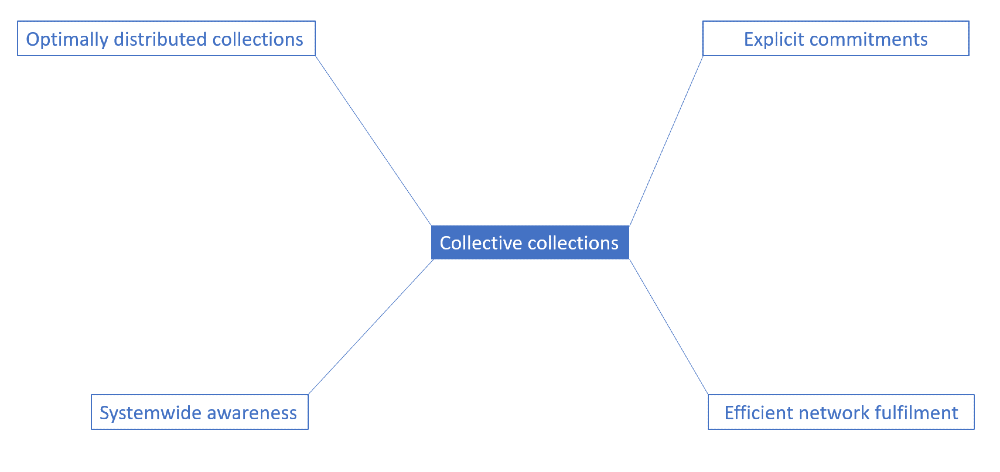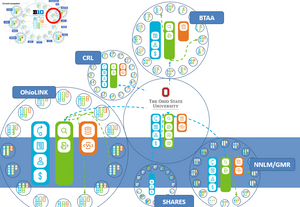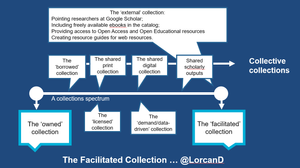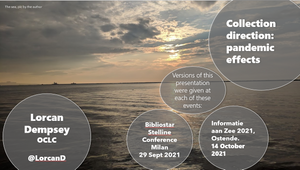Collective collections: what and why?
We are pleased to publish a discussion paper this week in collaboration with BTAA. It looks at choices that need to be made when operationalizing the BTAA collective collection.
In this introductory post, I briefly introduce some thoughts about operationalizing collective collections, drawing on the report.
Collective collections are collections addressed at a level above the individual institution, in a network context. OCLC Research has done a lot of work over the last few years looking at collective collections issues.
Collective collections are collections addressed at a level above the individual institution, in a network context.
We can characterize a collective collection by reach, by level of coordination, and by services offered. For example, a collective collection may be broad and loosely coordinated (e.g., all the materials visible through WorldCat) or it may be closely circumscribed and tightly coordinated or consolidated (e.g., the shared collection in ReCAP).
At the WorldCat collective collection level, available services include discoverability and resource sharing. OCLC also provides services which allow libraries and consortia to visualise collections and model decisions in the context of the overall collective collection. At the ReCAP shared collection level, available services include discoverability, resource sharing, consolidated management, and preservation of the print scholarly record.
Naturally enough, given their resource sharing role, consortia are major players in relation to collective collections. And we certainly see a trend toward more managed collective collections in consortial contexts. This is for several reasons:
- to extend the reach of materials available to users beyond those available at one library
- to make their management more efficient (by sharing costs and responsibilities)
- to coordinate collections above the individual library level, allowing individual libraries to specialize and contribute more extensively within a defined network of responsibilities
- to collaboratively steward the scholarly and cultural record
In BTAA, as elsewhere, the collective collection was guided by the “invisible hand” of aggregate local policies and decisions. Historically, collections evolved autonomously and locally within individual libraries. Stewardship of this collective resource was a benign side-effect of the massive distribution involved in the print model. To some extent this is still the dominant model for “purchased” or “print” collections.
As libraries manage down print collections, explore shared print models, and digitize collections this “invisible hand” approach is less adequate.
As libraries manage down print collections, explore shared print models, and digitize collections this “invisible hand” approach is less adequate. This is even more so as libraries unevenly reduce acquisitions of print collections, as more prospective collection coordination approaches emerge (where libraries collaborate to acquire in particular areas or from particular publishers), and as ebook collection become more commonplace. Indeed, print collections have come to share some of the characteristics of digital collections where distribution does not necessarily involve physical redundancy in multiple locations, and more active intervention or conscious coordination within a network of explicit commitments is desirable.
Attributes of a consciously coordinated collective collection
In the report, we describe four attributes of a more consciously coordinated collective collection, as shown below. Each involves decisions about investment of attention and resources.
The discussion here draws on the work of Brian Lavoie and Constance Malpas in Stewardship of the Evolving Scholarly Record: From the Invisible Hand to Conscious Coordination. It adapts the framework presented there for these specific purposes.

- Explicit commitments: More purposeful coordination depends on agreed strategies, processes for decision making and resource allocation, and broadly adopted policy frameworks. The most important element is an actual commitment to manage, build and share collections in a more coordinated way. Processes for decision making, resource allocation, oversight and review, sourcing, and so on, need to be developed.
- Efficient network fulfillment: An effective applications framework is required to allow users to easily discover resources of interest and to have them delivered quickly. We argue that in addition to discovery and delivery, BTAA should increasingly consider aggregating transaction data to support decision-making, which we refer to as dashboard functionality in the report. The applications framework is a principal focus of the influential D2D reports published by BTAA in recent years.
- Optimally distributed collections: Current approaches are layered over autonomously developed collections. More purposeful coordination of collections across the libraries will improve the overall performance of the network. This includes investigation of prospective collection development, shared print initiatives, selective digitization, the utilization of shared repositories as logistical hubs, and so on.
- Systemwide awareness: Effective management depends on good intelligence about the stocks and flows within the network: a unified view of the whole collection and how it is distributed, what ILL flows there are, and so on. Ideally, one would benefit from a unified view of shared print commitments, of items with digital surrogates, and of transaction data. A consolidated view of ILL policies, which could be looked up by applications, would also benefit.
We argue that each of these areas would benefit from stronger coordination to improve the efficiency and impact of collective collections.
The report covers each of these areas in some detail and places the discussion in the context of consortial choices around consolidation and autonomy.
It also emphasizes the importance of strategy, organizational, policy and process choices alongside the often discussed applications and collections choices.
We hope it is generally useful as libraries and consortia continue to evolve how the print collection is increasingly managed in collaborative settings.
Acknowledgements:
This blog entry is based on the text of Operationalizing the BIG Collective Collection by Lorcan Dempsey, Constance Malpas, and Mark Sandler.
The report also draws on our thinking about library consortia:
Dempsey, Lorcan (2019) “What Collaboration Means to Me: Library collaboration is hard; effective collaboration is harder,” Collaborative Librarianship: Vol. 10 : Iss. 4 , Article 3.
Our thinking was influenced by a broad range of discussions with colleagues in BTAA libraries, in OCLC, and in other organizations with an interest in these topics. A full list of acknowledgements is included in the report
Picture: Adapted from pictures in the report. Original by Constance Malpas.
Note: Cosmetic amendments on 28 March 2021, including adding feature picture and headings.




